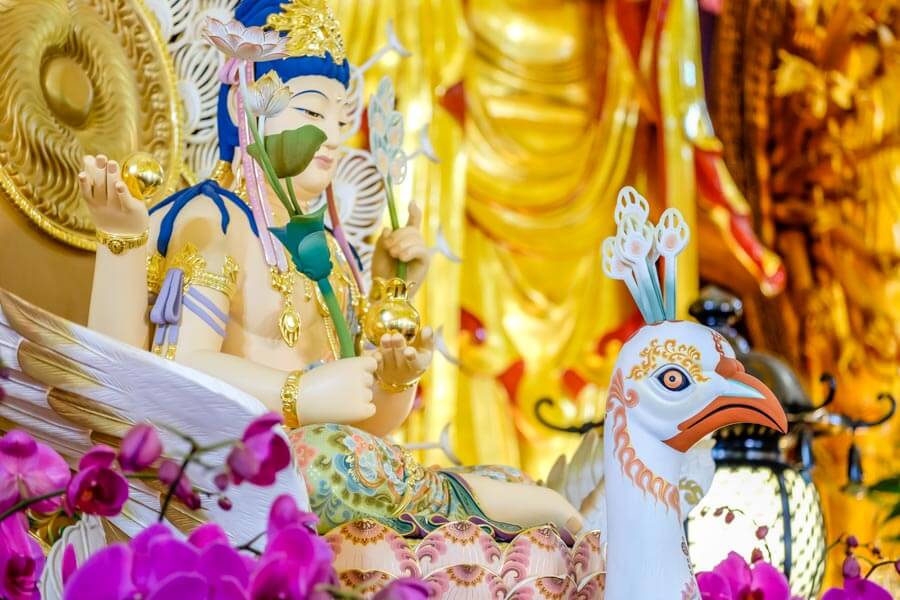Translated By Tony Qin
Many people have asked about the meaning of the term “Buddha Mother” in the title Buddha Mother Great Golden Radiance Peacock Wisdom King Sutra, so I would like to offer a brief explanation:
“Buddha Mother”: Volume 6 of the Sutra on the Buddha’s Great Skillful Means for Repaying Kindness states:
“The Buddha takes Dharma as his teacher,
the Buddha arises from Dharma,
and Dharma is the Buddha’s mother.”
Here, “Buddha” broadly refers to all Buddhas, while “mother” implies source or origin. Since all Buddhas attain enlightenment through prajñā (transcendent wisdom), “Buddha Mother” refers to prajñā itself.
“Great”: Signifies something supreme, unmatched, vast, and boundless.
“Golden Radiance”: Like a golden sun rising and shining its light across the earth, bringing illumination to all.
“Peacock”: The peacock is known for eating poisonous insects and plants, which do not harm it but instead enhance the brilliance and color of its feathers. The Lower Volume of the Peacock Sutra states:
“Greed, Anger, and Ignorance are the Three Poisons of the world.
The Buddha, Dharma, and Sangha have eradicated them,
and the poison of falsehood has been dispelled.”
The peacock’s traits serve as a metaphor for the virtues embodied in this sutra.
“Wisdom King”: Chapter 13 of the Miscellaneous Record of Authenticity states:
“Wisdom is represented by brightness. One who uses the power of wisdom to destroy the karmic obstacles of afflictions is called a Wisdom King.”
“Sutra”: Refers to any scripture that aligns with the Buddha’s teachings to liberate sentient beings and resonates with their potential for enlightenment. The term also conveys the idea of penetrating all phenomena and remaining constant throughout past, present, and future.
This sutra’s title follows the three aspects of naming (Note 1): Dharma, Metaphor, and Person. “Buddha Mother” represents Dharma, “Great Peacock” represents Metaphor, and “Wisdom King” represents Person. Together, these elements reflect the profound power of this sutra to eliminate the Three Poisons of Greed, Anger, and Ignorance, helping sentient beings attain enlightenment, freedom from suffering, and genuine happiness.
Characteristics of the Wisdom King
In Buddhist depictions, Wisdom Kings are often portrayed in fierce forms, subduing evil forces. However, the Peacock Wisdom King is unique, appearing in a compassionate form, and is sometimes referred to as a Bodhisattva. To avoid confusion with other Bodhisattvas, we consistently refer to this figure as the Peacock Wisdom King or the Revered Peacock Wisdom King.
According to the Ritual Manual for the Altar and Image of the Great Peacock Wisdom King as Taught by the Buddha (Note 2), translated by Master Amoghavajra, the Buddha Mother Wisdom King is usually depicted seated in a lotus posture, atop a white or blue lotus on a golden peacock. The figure radiates compassion and has four arms:
- The first right hand holds a fully bloomed lotus, symbolizing reverent affection.
- The second right hand holds a “Fruit of Co-arising” (resembling a papaya), symbolizing subjugation.
- The first left hand, placed at the heart, holds a “Fruit of Auspiciousness” (shaped like a peach or plum), symbolizing enrichment.
- The second left hand holds three or five peacock feathers, symbolizing the pacification of calamities.
The Upper Volume of the Peacock Sutra says:
“The Buddha said to Ānanda:
‘Was the Golden Radiant Peacock King of the past someone different?
He was none other than myself.'”
Here, “none other than myself” refers to Shakyamuni Buddha, who is also an emanation of Vairocana Tathāgata, embodying the dual virtues of guidance and subjugation. Hence, the two types of lotus seats: the white lotus, symbolizing the vow of compassionate guidance, and the blue lotus, symbolizing the subjugation of afflictions.
What, then, is the significance of the Wisdom King sitting on a lotus atop a peacock? Doctrine of the Golden Wheel, in Volume 29 of the Oral Notes of the White Jewel, offers this explanation:
“According to the principle of the intrinsic purity of Lotus Samadhi, the Dharma body transmutes the three poisons and the five desires to cultivate itself. At this stage, the three poisons are simultaneously severed. Just as the peacock nourishes itself by consuming all kinds of poisonous creatures, this represents the teaching that afflictions are, in essence, enlightenment. Therefore, the Great Sun Buddha manifests in this form within the Golden Realm.”
Some have also wondered whether the Wisdom King represents a female figure. In the Ellora Caves in western India, which date back to the 7th to 11th centuries, the Peacock Wisdom King is depicted as a female deity. However, in the mural of the Peacock King Mandala on the ceiling of Cave 205 in Dunhuang’s Mogao Grottoes, painted during the Five Dynasties period (10th century), and in the 12th-century depiction in the Tokyo National Museum, the Peacock Wisdom King is shown as a male figure with delicate eyebrows, long eyes, a small, full mouth, and a mustache. This depiction emphasizes compassion, while the mustache is symbolically linked to masculinity in Buddhism. Thus, the Revered Peacock Wisdom King is neither male nor female but embodies both qualities, always presenting a compassionate appearance to guide sentient beings toward enlightenment.
(Note 1) According to the Tiantai school, all sutra titles consist of three aspects: Person, Dharma, and Metaphor. These can be further classified into single, compound, or complete forms, for a total of seven types.
(Note 2) Taishō Tripiṭaka, T. 983, Volume 19

